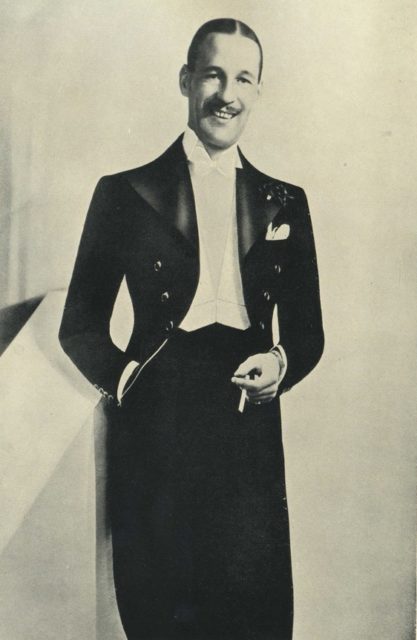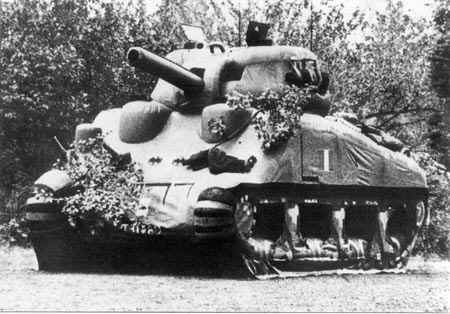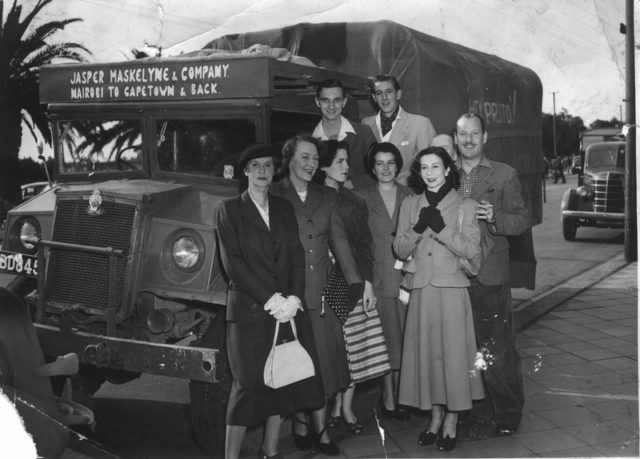Jasper Maskelyne (1902–1973) belonged to a well-known family of British stage magicians; he was the son of Nevil Maskelyne, and his grandfather was John Nevil Maskelyne, the inventor of the levitation trick.
Jasper performed during the 1930s and 1940s and is famous for his accounts of his work for British military intelligence during the 1940s, during which he claims he devised many methods of subterfuge, camouflage, and deception to fool the Axis Powers.

When the Second World War broke out, Maskelyne joined the Royal Engineers, hoping his skills could aid the Allied forces. He was trained at a camouflage development center at Farnham Castle in 1940. Maskelyne stated that the training was boring and that, due to his family history and time spent on stage, he probably knew more about magic than anyone there. Brigadier General Dudley Clarke, in charge of the deception department, enlisted Maskelyne to work for MI9 in Cairo, Egypt. There he taught escape techniques and invented small devices to assist captive soldiers, such as tools hidden in cricket bats and small maps incorporated into objects such as playing cards. In January of 1941, Field Marshal Sir Archibald Wavell created “A Force” for subterfuge and counterintelligence. Maskelyne was assigned to “A Force” and assembled a group of fourteen experts, including an architect, stage-set builder, carpenter, chemist, electrical engineer, electrician, and painter. The group was called the “Magic Gang.”
Maskelyne was temporarily a member of Geoffrey Barkas’s camouflage unit at Helwan, Egypt, created in November 1941, and was put in charge of the “Camouflage Experimental Section” at Abbassia, a neighborhood in Cairo. Unsuccessful in his assigned work, he was transferred to North Africa to entertain soldiers with magic tricks in February of 1942.

In October of 1942, before the second battle of El Alamein, Maskelyne was tasked with tricking German Field Marshal Rommel, the “Desert Fox”, into thinking the attack was coming from the south. In truth, British General Bernard Montgomery was planning to attack from the north, with a secondary attack on the south during Operation Bertram. One thousand tanks were disguised to look like ordinary trucks. Using painted plywood and canvas, Maskelyne was able to make jeeps look like tanks, complete with imitation tank tracks.
In the south, Maskelyne and his helpers created two thousand fabricated tanks with pyrotechnics. There were false railway lines, phony radio conversations, and imitation sounds of construction. A fake water pipeline was also set up, made to look as if it would never be completed so the area would not appear worth attacking. Maskelyne claimed to have invented an inflatable tank as well, to over-represent the Allies’ available forces.
Maskelyne’s book about his achievements, Magic: Top Secret, probably ghostwritten by Frank S. Stuart, was published in 1949. In his 2014 book Dazzled and Deceived: Mimicry and Camouflage, Peter Forbes, a Royal Literary Fund Fellow at the Queen Mary University of London, described “extravagant claims of cities disappearing, armies re-locating, dummies proliferating (even submarines) – all as a result of his knowledge of the magic arts.”
A study by former British soldier Richard Stokes, who would become Lord Privy Seal in 1951, reveals that much of the story about the participation of Maskelyne in counterintelligence operations as described in his book was an invention by the flamboyant Maskelyne and that no unit called the “Magic Gang” existed. The Guardian once wrote in 2002: “Maskelyne received no official recognition. For a vain man, this was intolerable, and he died an embittered drunk. It gives his story a poignancy without which it would be mere chest-beating.”

In 1947, Maskelyne’s wife Evelyn died, and within months he remarried a woman named Mary, who joined him in his passion for alcohol. About Maskelyne’s career after the war, his son Alistair remarked, “During this period the traveling magic show gradually moved to firstly the second layer or level music hall circuits, and later, still further to the third level, in small towns like Minehead in Somerset and industrial towns like Wigan and Chester. It was then the conjunction of the strip artiste, and the magic show took place: the lady who stripped was no longer young, and the whole presentation was tawdry.”
Maskelyne and Mary later moved to Kenya, where they bought a farm. Maskelyne became a police officer and fought against Mau Mau terrorists. He died in March of 1973 at the age of 70.
A movie, The War Magician, is currently in development by Storyscape Entertainment. It has been in the works since 2003, initially casting Tom Cruise as Maskelyne, but was shelved due to problems in finding a director. The project was picked up again a few years ago, and Benedict Cumberbatch is now being considered for the title role.
